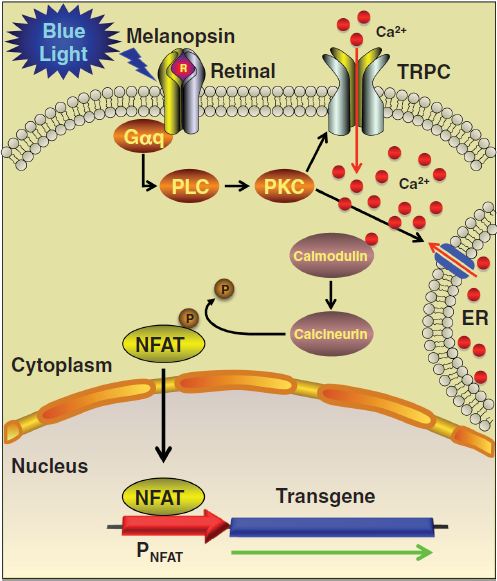Contents |
The "SWITCH" Project
In a nutshell
Our project is all about implementing a light activated genetic switch into mammalian cells. The production of complex proteins that require proper folding is becoming a more and more commonplace task in the pharmaceutical industry among others. Mammalian cells are an ideal environment to make these proteins but getting them produced at the right time and at the right rate requires an expression system keyed to a specific signal. Until now these systems have mostly been limited to chemical signals which have many drawbacks. By using a light activated expression system, we hope to get mammalian cells to respond to a light signal with gene expression.
A new expression system: LovTAP fusion protein
Our main goal this summer was to implement a previously untested expression system into mammalian cells. The LovTAP-VP16 fusion protein we used is based on a previously used fusion protein, LovTAP, which binds to DNA at a specific site once it is activated with blue light. By attaching an activating domain to the protein that is known to work in mammalian cells, we hoped to get it to bind DNA after exposure to light and promote expression of a gene next to its binding site.
Another approach: Melanopsin
We also worked with another light activated expression system that has already been proven to work. Martin Fusseneger et al. have designed a pathway that makes extensive use of gene expression pathways already present in the cell. By adding a light activated receptor on the cell membrane they promote the release of calcium into the cytoplasm upon exposure to light. This activates the native response to an increased calcium concentration and promoter proteins sensitive to calcium will signal for the expression of genes with specific promoter sites. By introducing a new gene with a calcium sensitive promoter next to it, we can use light to induce its expression.

CHO cells & Co
The light activated expression systems we worked on would be extremely convenient for production of proteins in an industrial context and CHO (chinese hamster ovary) cells are the workhorses of industrial protein production. For our project, we transfected these cells with each expression system and conducted a battery of tests. Along with this cell line we also chose to try them out on HEK (human embryonic kidney) cells since the melanopsin system had already been proved to work in them and that would provide comparable data for our LovTAP-VP16 system.
In each different cell line we tested a transfection containing a light-sensitive protein and a target gene or readout. We chose to express easily detectable fluorescent proteins so that we could compare the efficiency of both systems in turning on a particular gene. The target gene can then be replaced by a pharmaceutical product encoding gene.
 "
"